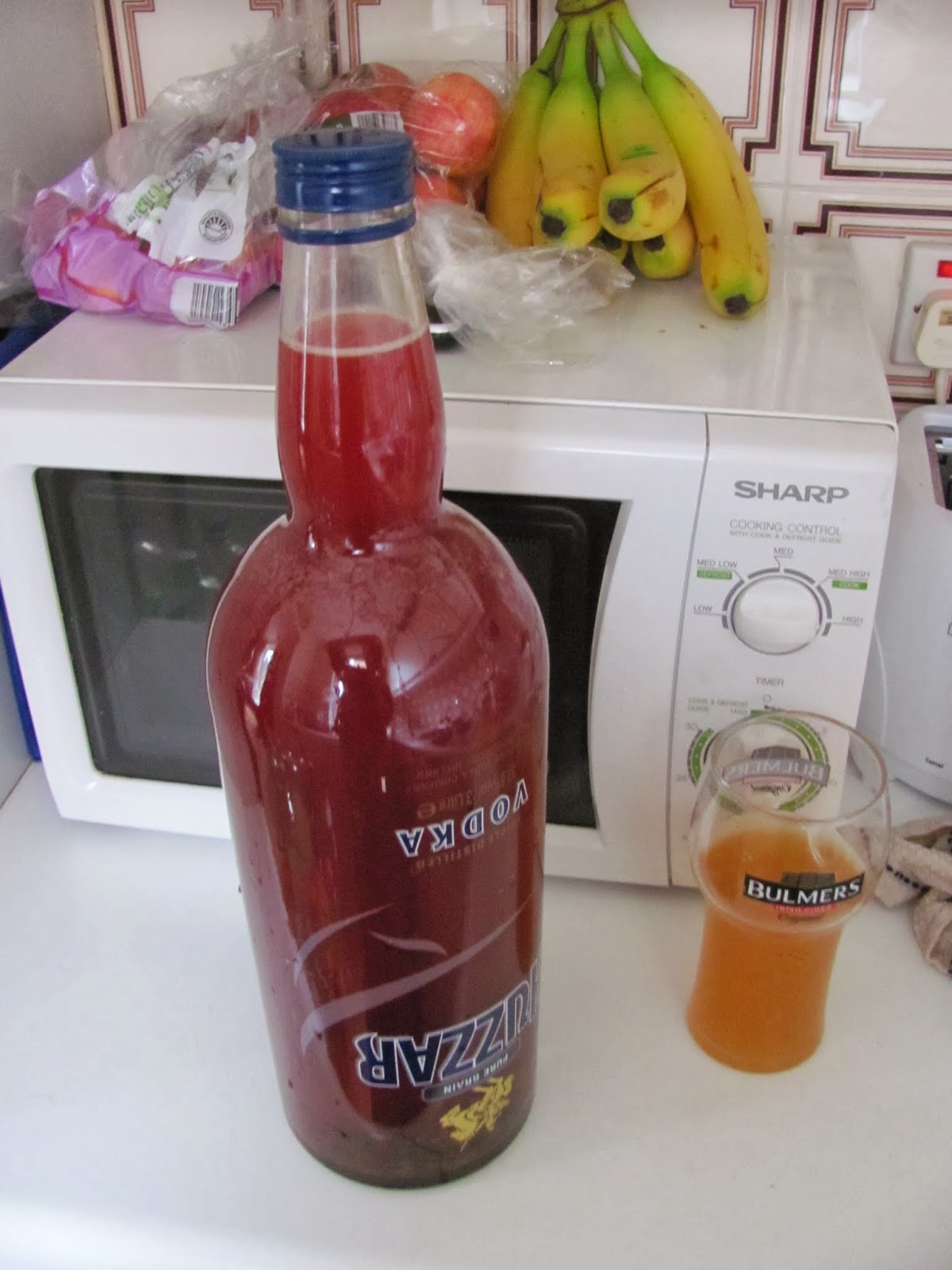Grape Wine in a Mason Jar
Deciding to maximize my kitchen mess on my big bottling day, I purchased one liter of 100% grape juice from a rare trip to Lidl, the hard-to-pronounce discount supermarket chain.
I brought out my old, trusty vodka bottle fermenter and cleaned it while I had the sanitizer mixed up for my beer and cider bottles. We purchased some cheap sultanas (like golden raisins) on our last grocery run, but were horrified to discover they had seeds in them! We gamely tried using them in our morning oatmeal, but we were just too spoiled to work around big chunks of seeds. Luckily, they make a great addition to wines and ciders for flavor and yeast-action enhancement.
I mixed up the sultanas and sugar with some boiling water to dissolve, mixed in the grape juice, and topped it off with cold water to bring it to desired volume and temperature.
 |
| Grape Juice Wine Ingredients |
Once the juices and fruit were mixed in the bottle, I poured in the yeast bed leftover from the Ciderlab Cyser- saving me a half packet of yeast. Bonus!
 |
| Mixed-and-Yeasted Juice |
Let's explain that for the non-experienced brewers so they don't repeat my mistake. Fruit (like sultanas or raisins) sinks when submerged in a dense liquid like pre-fermented wine or cider. With the fruit settled firmly on the bottom of the bottle, the brewer feels confident in walking away. What the brewer (like me) doesn't know or forgets is the process of fermentation- and its consequences.
The yeast go to work on that fruit (and the dissolved juice sugar) right away, fermenting the precious sugars into alcohol and carbon dioxide gas. Most of this gas escapes harmlessly to the top of the bottle and out of the "airlock." Some of this gas, when using whole fruits, stays inside the fruit skin, inflating it like a balloon. Suddenly, the now-gassy fruits do not sink in the dense liquid. They float.
This massive fruit-float event is aided by the now vigorous fermentation of the liquid. The juice is now full of bubbles and floating fruit, all pushing up to the narrow neck. In some unfortunate circumstances, the fruit can create a solid, airtight plug in the bottleneck, trapping all the fermentation gas below and putting the juice under tremendous pressure. Fermenters like this have been known to explode with thunderous force and with spectacular jets of sugary, sticky, staining liquid.
Luckily, I realized my folly before the fruit was able to create this airtight plug. I was close, as the neck was filling up with sultanas and the gas was struggling to get through and escape. My next half hour was spent fishing out floating raisins with a sanitized fork, cursing myself for making this critical error, wondering how what seemed like a small handful of sultanas could have reproduced into the approximately 700 pieces it seemed I was pulling out, and thanking my lucky stars I had found it in time. There would be no explosions rocking our kitchen this night!
Stay tuned for the thrilling taste test of this fine wine.
In Cyser News
The Ciderlab Cyser turned out rather well. I had mixed in some old honey, and was pleased that a little bit of that honey taste lingered in the finished product. It also finished on the sweet side, and I attribute some of this to the not-quite-fully-fermentable honey sugars and the cider yeast I was using, formulated for sweeter ciders. We usually have our ciders on the dry side, so when I've finished this round of cider yeast, I'll try to find some champagne yeast for the next few batches. Champagne yeast was my old cider standby in Iowa, and it never steered me wrong when I wanted a dry sparkling cider.

No comments:
Post a Comment
Please leave a comment, we'd love to hear what you think! Comments are word verified to prevent SPAM.